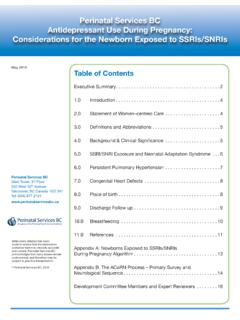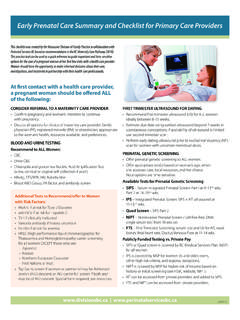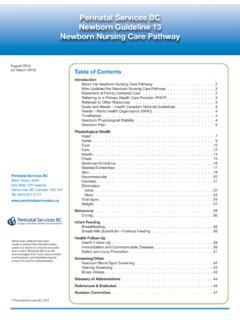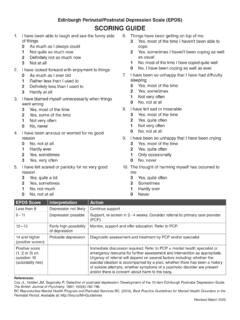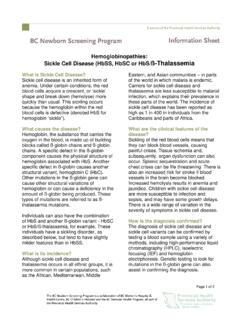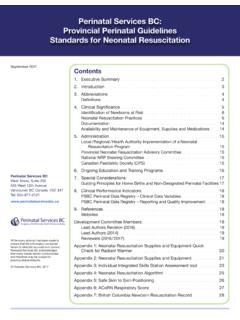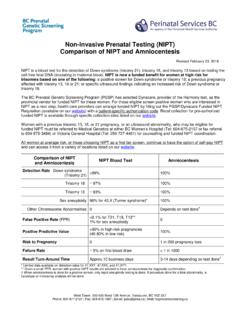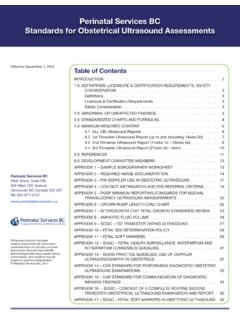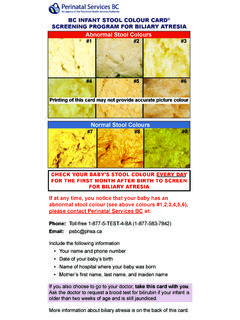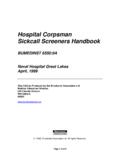Transcription of Guide for Completion of B.C. Newborn Resuscitation …
1 While every attempt has been made to ensure that the information contained herein is clinically accurate and current, Perinatal Services BC acknowledges that many issues remain controversial, and therefore may be subject to practice interpretation. Perinatal Services BC, 2014 Perinatal Services BC West Tower, Suite 350 555 West 12th Avenue Vancouver, BC Canada V5Z 3X7 Tel: y 2014A Guide for Completion of the British Columbia Newborn Resuscitation record (PSBC 1583B)Table of Introduction .. Abbreviations .. Role of the Recorder .. Completion of the Form .. 4 Top Section .. 4 Section 1: Time .. 4 Section 2: Assessment .. 4 Section 3: Interventions .. 5 Section 4: Notes .. 6 Signatures .. 6 Additional Narrative Notes .. PSBC Perinatal Data Registry .. 7 Clinical Data Variables Reported For Quality Improvement.
2 7 References .. 8 Members of the Newborn record Revision Working Group .. 8 Obtaining Copies of the BC Newborn Resuscitation record .. 8 Appendix 1 British Columbia Newborn Resuscitation record .. 92 Perinatal Services BCNotes written well after the neonatal Resuscitation are influenced by the recorder s memory and perception of what occurred. Studies have found that documentation of Resuscitation varies considerably from actual interventions, including number and duration of intubation attempts, duration of PPV, and on occasion, even failure to record the use of chest compression (Rich, Leone and Finer, 2010).Typically, a team member is assigned this role at random and most often to the least experienced staff nurse. One study reported that 63% of the Resuscitation records had documentation problems, mostly related to where and how the information was entered on the form (Stewart et al, 2002).
3 The literature recommends that a code sheet be used to document the neonatal Resuscitation as it occurs, and that a team member assume the role of recorder, just as in other patient code situations (Stokowski, 2008).Perinatal Services BC Newborn Resuscitation record (PSBC 1583B rev. OCTOBER 2013) is a form developed for the documentation of a neonatal Resuscitation , and is consistent with the Neonatal Resuscitation Program (NRP) guidelines. It is a tool that also facilitates communication and continuity of care between facilities and providers of care. This form should be used at the time of birth to document Resuscitation requiring the use of oxygen or positive pressure ventilation in the delivery setting, but can be used in any setting where a neonate requires Resuscitation or to capture a neonate s deteriorating status, where a poor outcome is documentation done on separate pieces of scrap paper should be attached to the form to ensure no information is fields on the Newborn and Resuscitation records are collected as part of a comprehensive database for the British Columbia Perinatal Data Registry (BCPDR).
4 The mandate of Perinatal Services BC (PSBC) includes the collection and analysis of perinatal data to evaluate provincial perinatal outcomes, and to improve health care AbbreviationsAx axillaBCPDR British Columbia Perinatal Database RegistryBP blood pressureCPAP continuous positive airway pressureEPI epinephrineETT endotracheal tubeHR heart rateLMA laryngeal mask airwayLMP last menstrual periodlpm litres per minuteNICU neonatal intensive care unitNRP Neonatal Resuscitation ProgramO2 oxygenPPV positive pressure ventilationPIP peak inspiratory pressurePEEP peak end expiratory pressurePSBC Perinatal Services BCRESP respirations or respiratoryTEMP temperatureUVC umbilical venous catheterVOL EXP volume Introduction3A Guide for Completion of the British Columbia Newborn Resuscitation record (PSBC 1583B)The purpose of the Resuscitation record is to facilitate clear, concise, factual, objective, timely documentation.
5 Delay in documentation can cloud the memory of events, increase the possibility of errors and affect the continuity of care. However, the confusion and urgency of most Resuscitation efforts prohibit accurate event documentation if one person is not assigned the role of recorder. Other challenges to recording include the following ( Resuscitation Central, 2010): It is not clear if the form should be completed or not. For example, when the neonate requires only a few assisted ventilations. The form is not quickly located and accessible to begin documentation. The recorder is unfamiliar with the form, data requested and / or the NRP algorithm. Different clocks are used to enter times onto the form. The data on the form is incomplete and / or of the Recorder include: Identify / confirm the recorder as soon as possible, preferably before the birth.
6 Have no other role during the Resuscitation so that full attention can be given to collecting the needed data and following the multiple interventions that often occur simultaneously. Have working knowledge of the NRP algorithm and familiarity with the information needed and how to obtain it. For example, the documenter may need to request that when any medication is administered IV push to the patient, the provider announce when it is in so that the time of documentation can be accurate . Communicate with the Team Leader throughout the Resuscitation which interventions have been done (should be an experienced health care provider who can anticipate Resuscitation needs). Maintain an accurate written record of the timing of all interventions, documenting the events of the Resuscitation as they PointGenerally, a nurse documents only the care she / he provides, does not allow others to document for her / him, and does not document care that anyone else provides.
7 There are two exceptions to this rule: in an emergency, such as a cardiac arrest when you are designated as recorder, document the care provided by other health professionals record a verbal order when circumstances require doing so (CRNBC, 2008). Role of the Recorder4 Perinatal Services BCIf the neonate s label or addressograph is not available, record the neonate s last name, gender, multiple if appropriate, date and time of birth in the upper right hand corner of the record . The patient s label or the addressograph stamp should also be placed in this SectionThe top section of the record should be completed immediately after the event. Event Date - record the date of the event. Time - record the time the event began. Gestational Age - Use LMP, sonogram / ultrasound or by exam. Weight - Indicate estimated weight or actual weight.
8 Location - Check the area in which the Resuscitation occurred. Birthing Room includes a labour delivery room, single room maternity care. For Other, record the area such as the mother s residence (for example if midwife attended home birth), postpartum ward or emergency department. Stamp with the neonate s Addressograph. Page # of - record the page number and the total number of pages utilized to document the 1: TimeItemDescriptionACTUAL TIME or AGE (in minutes) Either actual time on a wall clock OR age in minutes from an Apgar timer It is important to chart the time at which all major events or decisions took place The more complex the Resuscitation , the more entriesSection 2: AssessmentNote: do not leave blank lines between entries. Do not squeeze entries between EFFORT record the respiratory effort utilizing the following codes = good / cryingH = hypoventilation (defined as breathing that is too shallow or too slow and thereby unable to meet the needs of the body)0 = absent record in the Notes section if the respiratory effort is laboured ( tachypnea, grunting, refractions)HR (per minute) record the auscultated, palpated or monitored heart rateO2 SATURATION (%) record the preductal (right hand or wrist) oxygen saturation as per the pulse oximeterCOLOUR record the color utilizing the following codesP = pinkM = mottled / paleC = Completion of the Form5A Guide for Completion of the British Columbia Newborn Resuscitation record (PSBC 1583B)
9 ItemDescriptionTONE record the tone utilizing the following codes = active motionSF = some flexionH = hypotonic / flaccidTEMP C (axilla or skin probe) Indicate what the temperature is and method by which it is monitored: A (axilla) or SP (skin probe) Servo-controlled temperature probes are applied to all neonates by 10 minutes of life and the temperature reading recordedSection 3: InterventionsItemDescriptionDEVICE record the ventilation device used by checking T-piece, self inflating or flow inflating If the device is changed during the Resuscitation , record the reason in the Notes sectionO2% ON BLENDER record the amount of oxygen delivered as per the oxygen / air blender This will include PPV, CPAP or free-flow oxygen administrationVENTILATION RATE (per minute) record the number of breaths per minute administeredPIP / PEEP or CPAP (cmH2O) For Positive Pressure Ventilation (PPV) record PIP on the top of the slash and PEEP below the slashPIP 5 For Continuous Positive Airway Pressure (CPAP) record the pressure below the slash 5 MASK (M)LMAETT In the column, record the interface ( Mask, LMA or ETT)
10 Used to administer PPV or CPAP In the Notes section, document the LMA size and name of the person who successfully / unsuccessfully inserted it In the Notes section, document if the ETT insertion was successful / unsuccessful, number of attempts, tube size, confirmation method, and name of the person who successfully / unsuccessfully performed the intubation procedure Appropriate sized endotracheal tubes are as follows and should be recorded: ETT ( 1kg) ETT (1 to kg) ETT (> kg) Completion of the Form, cont' Services BCItemDescriptionCHEST COMPRESSIONS Indicate administration of chest compressions with a checkmarkSection 4: NotesItemDescriptionNOTES record important information during Resuscitation not captured in the previous sections, including who performed invasive interventions, response to interventions and meconium management Type of suctioning (oropharyngeal or tracheal) and type / amount of secretions ETT and UVC insertion (tube / catheter size, insertion depth, who inserted, confirmation method) Medications and volume expander administration (including dose, route, name of person who administered) Procedures or diagnostic tests (include blood volume taken for the test), completed and results (if reported) Time extra help arrived and who they were Neonate s condition post Resuscitation Transfer for post Resuscitation / stabilization and ongoing care (including where to and how transported)
